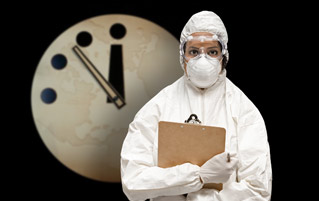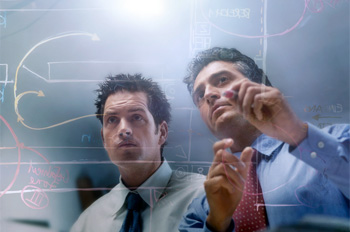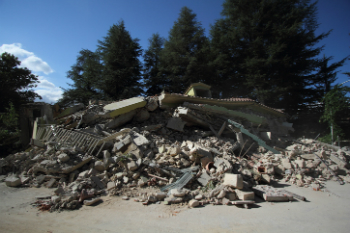5 Official-Sounding Measurements That Are Complete BS

Raise your hand if you've ever walked outside on a hot summer day, said, "Damn, what's the temperature out here?" and checked a weather app on your phone. Even though you can feel the actual heat, you want to attach a number to it. It's human nature.
We put so much faith in numbers, in fact, that we don't bother to look too closely at where they come from. For example, did you know ...
The Doomsday Clock Has Precisely Zero Scientific Basis
We've all heard of the Doomsday Clock, right? Every now and then it makes the news with an ominous headline ("The Doomsday Clock is now JUST THREE MINUTES FROM MIDNIGHT") and it just got bumped further up by 30 seconds because something something, orange complexion, small hands, weird hair, Twitter. It's a spooky, ominous measurement of how close we are to Armageddon, and it's coming from scientists so you know that shit's as real as it gets.
No, hold on. Did we say "real"? Because we meant "vague and utterly meaningless."

The Doomsday Clock is a tradition upheld by an obscure science magazine called the Bulletin Of The Atomic Scientists (a name perfectly suited to its founding in 1945). The placement of its hands is decided by a bunch of scientists and climate researchers, who periodically get together to talk about how worried they are about things in general. So that's the first misconception about the Clock: the only thing it actually measures is the worry of a few people.
In all fairness, said people are esteemed scientists. However, scientists often don't know shit outside their own, narrow fields of expertise, so making a bunch of them from different fields discuss wide-spanning global issues probably isn't all that far from you and your coworkers shooting shit at the water cooler. Sure, you and your office buddies might not run your Fantasy League speculation by several Nobel Laureates like the Doomsday Clock posse does. But since said Nobel Laureates also tend to have very little expertise in the subjects at hand, that's probably for the best.

Anyway, the consensus from these meetings is published in the Bulletin, complete with the updating of a symbolic logo they call the Doomsday Clock. That's it. That's the whole thing. What does it mean to be five minutes to midnight instead of six, or ten, or forty? Nothing. And now you know why the Doomsday Clock folks once randomly counted the Fukushima nuclear disaster right up there with Cold War nuclear proliferation, completely ignoring the fact that Fukushima happened because of an earthquake and tsunami while the latter's cause was massively powerful countries locked in a deliberate arms race of mutually assured destruction.
Hell, even the very "minutes to midnight" concept of the Doomsday Clock is not just flawed, but actually the exact opposite of a scientific process. The clock was originally set at seven minutes to midnight ... for no good reason at all. Martyl Langsdorf, the artist who designed it, chose that reading for this heavily revered symbol on the basis of "it looked good to my eye."
That pretty much says it all.
The Better Business Bureau Was Caught Extorting The Businesses It Grades
The Better Business Bureau, you might imagine, grades businesses based on their ability to serve their customers with integrity, reliability, and fairness. It's an easy way to tell if the company you're about to buy from is going to screw you over ... which means the BBB's own integrity better be roughly equivalent to Captain America's.
Yet, in 2010, an ABC News investigation recorded the attempt of Terri Hartman, a Los Angeles small business owner, to change her C grade (issued due to a complaint that had since been resolved) by phone. The BBB representative told her that she could only change her grade by buying a membership. Hartman duly paid up and, the next business day, her business had an A+ grade and the complaint was removed from its record. Carmen Tellez, another Los Angeles business owner, experienced the same thing when she tried to change her C- grade.

And of course that's not as insane, or as nakedly mercenary, as it gets. For $425, the BBB issued an A rating to a fictional business named Hamas, named after the Palestinian fundamentalist organization and completely made up by a group of Los Angeles business owners. Stormfront, a neo-Nazi website, was registered with the BBB as a prank by someone using the name "Aryan Whitney." Clearly fooled by the subtlety, the BBB gave them an A+ rating for yet another $425.
The CEO of BBB stated that all these grades were made in error. Which is something you might buy if it happened once, but if it happens three times, and then twice again while cameras are rolling, you start to suspect something is up.
Meanwhile, the notorious garbage heap known as the Ritz-Carlton in Boston received an F rating, based on a torrent of ... two complaints? Certain restaurants owned by celebrity chef Wolfgang Puck, who it just so happens refused to join the BBB, suffered the same fate. Disneyland? Also got an F. The BBB openly rated all of those things lower than goddamned Stormfront.

The ABC investigation uncovered a pretty clear pattern: Organizations that aren't BBB members receive an extremely low grade based on very few complaints and, unless they become BBB members, changing that grade is next to impossible. "It's a scarlet letter," lamented Brian Kraft, who spent over a million dollars in legal fees trying to sue the BBB. "These guys are bullies."
Seeing as he received a C in error and, when he tried to protest it, got downgraded to F, it's kind of hard to disagree.
The Traditional Scoville Scale Of Spiciness Was Subjective As Hell
The main tool in any chili aficionado's mouth torture kit is the Scoville scale, which is used the world over to determine the precise level of "heat" in food. Think of it as a scoreboard for the kind of people who are prepared to poop lava for fleeting bragging rights.
The Scoville scale gives fairly precise Scoville Heat Unit windows for each pepper type: Jalapenos are considered to max out at 8,000 SHU, habaneros can be up to 350,000, and certain high-end peppers can be somewhere around a sphincter-clenching two million SHU, which is on par with straight-up chugging pepper spray. And since the spiciness in peppers comes from a compound called capsaicin, it's reasonable to assume that the measuring process is simple and scientific -- just measure that shit, and write down the result. What you wouldn't expect is five dudes bickering about what's hot and what's not, and voting about the result.

The original process for determining a pepper's SHU is actually called the Scoville Organoleptic Test, and it consists of three simple steps: One, take some extract of a pepper and heavily dilute it with water and sugar. Two, give it to a panel of five tasters. Three, ask them how spicy they kind of feel it is.
You'll notice several problems with this approach. For one, everyone's taste receptors are wired differently; no one has exactly the same amount, so we all perceive spiciness at different levels, and certainly differently from five dudes with taster's fatigue who professionally rate chili peppers. And, while we're not explicitly stating this has happened, it doesn't seem out of the realm of possibility that when a few of these tasters have an off day and a random pepper actually does get to them ... well, let's just say that the kind of scale that ranges in the millions has plenty of room for personal bias-induced exaggeration.

When you take that into consideration, it appears the classic Scoville rating system is less "scientific" and more "a bunch of nerds arguing about the rules, only this time it's peppers instead of D&D." These days, experts prefer a process called HPLC, or high-performance liquid chromatography. It measures hotness the way you probably half-heartedly assumed Wilbur Scoville's original system did until just now. A sample of the chili fruit is dried and ground. Then, water is filtered through it like you were making coffee. Then, the liquid is scientifically measured for its capsaicinoids.
The end result is reported in American Spice Trade Association (ASTA) units, but since the figures they provide are around 15 times smaller than Scoville Units, the results are generally converted to SHU for the public. Popular Science says it's out of tradition, but let's face it, we all know the truth: If chili jocks one day woke up in a world where the crazy 1,000,000-SHU death sauce wrecking their digestive tracts would suddenly be hard-pressed to crack 70,000 units of whatever, there would be a revolution like none the world has ever witnessed.
Nobody Uses The Richter Scale Anymore
Even though few of us can explain off the top of our heads how it works, pretty much everyone has heard about the Richter scale for measuring the magnitude of earthquakes. It's a logarithmic scale that runs from 1.0 to 9.0 and beyond. Every number represents a tenfold increase in the earthquake's intensity, and the bigger the number gets, the less likely your neighbor's house is to be there anymore when you look out of the window (which may or may not be because said window is now blocked by the rubble of your own house).

So, when the news guy says that morning's quake was a minor 4.3, you have a general sense of what that means, thanks to this easy-to-understand scale. Only if you listen closely you'll notice many outlets stopped using the word "Richter" and will often talk around it (just saying a quake was "a magnitude "). That's because experts quietly stopped using the Richter scale because it's very limited ... and that happened almost 40 years ago.
The Richter scale was introduced in 1935 by seismologist Charles F. Richter as a tool to measure earthquakes ... of the type specific to California ... using a very particular type of seismograph. Earthquake-measuring systems weren't exactly flooding the market at the time, so it had to do. But quakes in Japan and elsewhere are very different, for a bunch of science reasons (they originate deeper underground, for one).

Since as far back as 1979, the kingpin of the earthquake measuring game has been the Moment Magnitude Scale, which is much more precise. Oddly, the media usually still says "Richter Scale" if they mention the scale at all, for the same cultural inertia reasons people keep referencing Scoville. If a breaking news bulletin interrupted our, uh, Netflix to say that San Francisco had just suffered a quake that was a "7.2 Moment Magnitude," Americans would react roughly the same as if they were told to expect "Five centimeters of rain."
Becoming AYou might expect the New York Times bestseller list to reliably indicate how well a book sells throughout the United States, seeing as it's pretty much the only authority in the "books that sell shitloads" field that anyone can name off the top of their head.
Which is when 1986 calls, and reminds you of the time William Peter Blatty sued the newspaper because his shitloads-selling sequel to The Exorcist wasn't included on the list, and the NYT lawyers basically coughed up a bunch of "editors gotta edit, newspapers gotta have bestseller lists" jargon and pleaded the First Amendment. Blatty lost his case, but according to people in the industry, the NYT Bestseller List is, let's just say, less than scientific.
What Blatty yelled at the judge immediately after hearing the verdict.
First, no one at the New York Times has access to some central database of book sales -- there is no such thing. Their list is a fairly rough estimate that strongly relies on the amount of books ordered in anticipation of sales by certain bookstores, as opposed to actual books sold to customers. Which bookstores get sampled, then? Why, that isn't public information ... for you. But, since making the list is a huge boost of free publicity, large publishing houses have managed to get a pretty good idea of which stores are counted and how the list works in general.
This, of course, leads to a whole lot of behind-the-scenes antics that mysteriously result in said publishing houses' books reliably getting on the list. Since the list targets relatively few bookstores, the amount of books needed to place for a given week can be fairly low (think around 20,000). They just need to be concentrated in the right stores, and they have to arrive within the right week. As a result, runaway hits sometimes get left off: Self-publishing phenomenon Amanda Hocking single-handedly shifted over a million books on Amazon, before she ever scratched the door of the NYT bestseller list.

Oh, and the list (along with others, such as the Wall Street Journal bestseller list) can totally be manipulated by the authors, too. There's a company called ResultSource, which effectively allows authors to game the system and simply buy their way onto the list. It's very straightforward -- ResultSource just buys a ton of their books from those select stores and disguises the purchases to make them look "organic."
For instance, in 2012, Pastor Mark Driscoll and his wife paid $210,000 to place one of their Christian self-help books on the list. But what's a couple hundred grand (and the entirety of your professional integrity, forever) when the payoff is getting to call yourself a "New York Times bestselling author" from here to eternity?

We did it the honest way. Cocaine and hookers.
Nathan Kamal lives in Oregon and writes there. He co-founded Asymmetry Fiction for all your fiction needs.
Also check out 6 Small Math Errors That Caused Huge Disasters and 8 Simple Questions You Won't Believe Science Can't Answer.
Subscribe to our YouTube channel, and check out How To Ruin Your Favorite Sitcoms With Simple Math, and other videos you won't see on the site!
Follow us on Facebook, and we'll follow you everywhere.